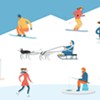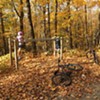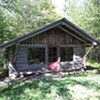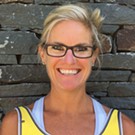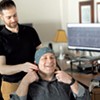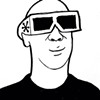Published November 10, 2004 at 5:00 p.m.
In a sunlit studio, three exercisers begin to rock back and forth on their heels. "Pum, pum," they chant, their voices competing with the George Winston CD in the player and the squeaking of the Stairmaster in the adjacent fitness room. "Pum, pum." The intoning and swaying stop, and they begin to walk around, throwing their legs around like Pinocchio, grabbing their bellies and biting their knuckles.
But nobody here at the Shelburne Athletic Club is about to drink deadly Kool Aid, worship a comet or clone a human being. This is no cult -- it's a new class that aims to maintain and regenerate bone health through a series of body movements. Its arrival in Vermont coincides with a new report that predicts osteoporosis will reach epidemic levels in the next 15 years.
Constructed of minerals, proteins and collagen fibers, the 200-plus bones in our bodies are among the strongest materials found in nature. When we're young, our bone tissue is constantly being replaced. But at a certain point --we achieve peak bone mass at age 30 -- new bone growth begins to slack off. When the ratio of old to new bone mass becomes too great, bone loss, or osteoporosis, occurs. Unbeknownst to us, our skeletons transform from sturdy support systems to networks of brittle sticks. A simple stroll to the mailbox can turn into a trip to the hospital.
For years, bone loss was largely thought to be a problem affecting elderly women. But researchers are now rethinking the extent of its reach. According to the first-ever U.S. Surgeon General's report on bone health, released last month, 10 million Americans aged 50 and older currently suffer from osteoporosis; by 2020, half of Americans that age will be at risk. The number of broken bones associated with the disease -- 1.5 million -- is expected to rise significantly as well. "Osteoporosis isn't just your grandmother's disease," said Surgeon General Richard Carmona. "Thirty years ago, doctors thought weak bones and osteoporosis were a natural part of aging, but today we know they are not."
At least 20 percent of people with osteoporosis are men, who often develop the disease because of smoking, heavy drinking, sedentary lifestyles or long-term use of certain medications. For women, just being female is a major risk factor. Heredity, low body weight or menopause may contribute to the problem.
In order to maintain bone health, doctors recommend quitting bad habits, ingesting sufficient amounts of calcium and vitamin D and, in the last decade, exercising in ways that involve bearing weight. However, new studies reveal that different ways of moving can have life-changing effects on our skeletons.
Veterinarians researching the "nine lives" of cats have examined the way felines move, jump, land and purr. One report in the Canine Health Concerns Digest suggested that a cat's purr is at a frequency that promotes bone growth and repair. In 2001, NASA-funded scientists, hoping to prevent bone loss in astronauts returning to Earth, discovered that 10 minutes of vibrations a day resulted in better bone formation than did weight-bearing activity.
These principles inform the philosophy behind "Bones for Life," a program developed by Israeli bodyworker Ruthy Alon. Trained in the Feldenkrais method, which teaches healthier body movements, Alon has developed a system for helping individuals change their movement habits in order to promote bone health. "It is the rhythmical pulsations of lively steps that enable the blood, which carries nutrients and oxygen, to penetrate the solid tissue of the bones and provide for growth of new bone cells," she writes on her website. Rather than burden students with heavy weights, Alon's approach focuses on controlled resistance to pressure, and on providing tools to practice these exercises at home.
Mischul Brownstone, a 20-year Feldenkrais practitioner who studied Bones for Life in 2002 with Alon, is responsible for bringing the program to the Shelburne Athletic Club and Touchstone Healing Arts. "This is not about what good posture is," he explains, "but rather the appropriate posture for each activity."
A typical class opens with the "pum pum" warm-up, a slight rocking of the heels. Accompanied by the vocal repetition, it aims to improve blood circulation and initiate vibrations for better bone strength. The chant may sound a little weird -- it's probably not something you'd want to practice while waiting in line at the Price Chopper -- but it allegedly helps the vibrations pass through the skeleton. The vibration work is further enhanced by walking, running in place, and adjusting various body parts -- hence the knuckle-biting and the belly-squeezing. Participants also go through stretch-like movements, twisting spines and pulling legs to chests to click their skeletons into alignment.
"We're after strong bones and good circulation to the bones," Brownstone says. "But at the same time, we're talking about realigning habits, and how power can get transmitted from end to end, and coordinating your whole body."
For anyone whose idea of a fitness program is, say, Jazzercise, the 90-minute Bones for Life workout may seem molasses-slow. The movements are gentle, and the group pauses regularly to check where everyone's "at" in their realignment. This self-assessment doesn't come easily to everyone. One woman calls her experience "ethereal." For some, that might seem a bit too vague to justify shelling out $190 for a 10-week Bones for Life session.
But patience has its payoffs. According to Alon's website, bone density tests on several of her students have revealed significant improvements. Claims range from reaching the "safe zone" to a return to the top of the bone-strength chart.
At the end of Brownstone's class, as the light piano music gives way to something slightly more South American, Jill Fox, 73, looks flushed and relaxed, floating around the room with light, springy movements. "They found my spine was practically hollow after I had a lung X-ray years ago," she says. "Now, I'm just about normal -- my hips have improved, my spine has improved. It's a lot about balance for me, an inner quietness, feeling centered, breathing right and finally walking better."
Some students claim the classes help them cope with Vermont's winter. Increased core strength and coordination helps participants more easily avoid spills. "I'm much more confident in the ice and snow," says Donna Lescoe of Starksboro. Before enrolling in the class, she used to feel sore after swing dancing or hiking the hilly terrain around her home. That's no longer an issue. At 51, she says she'll do whatever it takes to stay out of the hospital in the years ahead. "I can't do what I could at 20, but who can? I'm just trying to get the most out of my body."
More By This Author
Speaking of Health, health Wanted
-

'We Must Act Now': Burlington Council Passes Resolution on Drug Crisis, Public Safety
Oct 11, 2023 -

Q&A: Chet and Kate Parsons Talk About Their Final Lambing Season in Richford
Apr 12, 2023 -

Video: Last Lambing Season for Chet and Kate Parsons at the Parsons’ Farm in Richford
Apr 6, 2023 -

Garnet Health to Close, Citing Financial Difficulties
Jan 17, 2023 -

Vermont Will Lift School Masking Guidance on March 14
Mar 3, 2022 - More »
Comments
Comments are closed.
From 2014-2020, Seven Days allowed readers to comment on all stories posted on our website. While we've appreciated the suggestions and insights, right now Seven Days is prioritizing our core mission — producing high-quality, responsible local journalism — over moderating online debates between readers.
To criticize, correct or praise our reporting, please send us a letter to the editor or send us a tip. We’ll check it out and report the results.
Online comments may return when we have better tech tools for managing them. Thanks for reading.



































